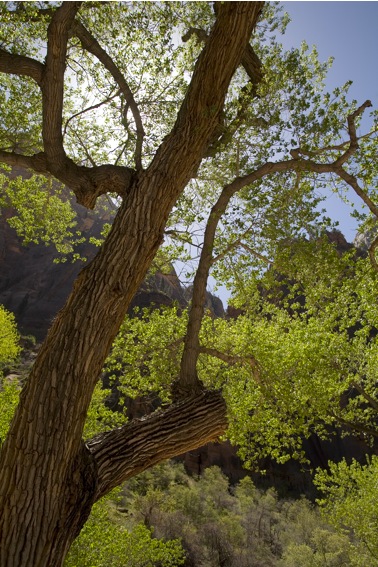Shooting into the Sun
Have you ever watched a movie in which the sun came into the frame and your eyes reflexively squinted (even though the brightest white that can be produced on the screen is quite benign)? Our natural instincts tell us to look away from the sun. So, aiming our camera towards the sun seems like the wrong thing to do — and it can be (for both our eyes and our cameras). However, there are times when it can be done, safely, and provide a great reward.
My technique here was to put the tree trunk and branches between the sun and the camera. Essentially, the camera was in the shadow of the tree. Using a wide-angle lens helps make the apparent width of the sun smaller (so easier to hide). My reward was some incredibly intense green from back-lit leaves, and some interesting lines made by the trunk and branches of the tree. The color produced by transmitting the sunlight through leaves far exceeded the brilliance of sunlight having reflected off the same leaves.
There are often two additional challenges when shooting into the sun: First, the sky can get very washed out. That, too, is minimized by using a wide-angle lens, and I was careful to place leaves against the bright part of the sky, drawing less attention to it. Second (and this isn’t always a bad thing), the objects you use to cast the shadow can become silhouetted — so lost in shadow that there is little detail. In this case, there was enough light reflecting back to show some nice texture in the trunk and branches; other times, having the branches go black makes for a very nice effect. This technique can also be applied to macro photography, particularly with leaves and flowers.
I first took took a shot at this location with an Olympus C5050-Z (5 megapixel) compact digital camera. The results were sufficiently encouraging that I went back several months later and retook this shot (pictured above) with an EOS-5D, equipped with an EF 20-35mm f/2.8L (set at 25mm focal length); exposure was 1/125s at f/5.6.

Tip of the Week
2007.01.22

